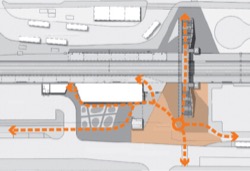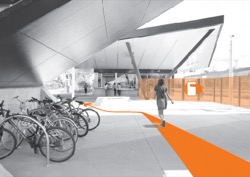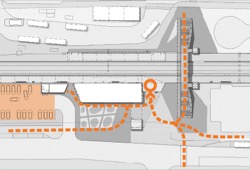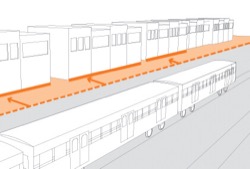On this page:
What is a public transport interchange?
A public transport interchange is a place where people can access or transfer between public transport modes and routes. Interchanges vary in size and may be stand–alone, adjacent to a railway station, or located at a transport node, such as a park–and–ride facility.
The interchange may be located in a building or an open area, with passenger facilities such as shelters and enclosed waiting spaces, travel information, public conveniences and shops.
Buses and trams are large vehicles with limited manoeuvrability, therefore detailed design must consider safety and engineering issues.
Why is it important?
Interchanges have a concentration of pedestrian activity accessing the interchange from multiple directions or changing modes. The movement patterns may have temporal peaks, often resulting in patchy activation. Functional, safe and convenient pedestrian movement to and within a public transport interchange is a major objective.
This element provides design guidance for the immediate surroundings of public transport interchanges. It does not include design considerations within a paid (ticketed) area.
The engineering, servicing or management issues of the public transport are guided by other appropriate authorities. Refer to Public Transport Guidelines for Land Use and Development.
4.2.1: integrate the railway station with the surrounding area
- Arrange railway station forecourts as a key part of the public space system and movement network.

Tip: station forecourts are both public spaces and arrival and setting–off points for a journey. - Locate convenience retail uses close to the station entry.
Tip: where a station kiosk or a shop overlooks the station approach path and platform, staff provide informal surveillance and passengers feel safer.
- Locate local pedestrian and bicycle crossings of railway lines outside the station ‘paid’ (ticketed) area.

Tip: by locating railway line crossings outside the paid area, the paths can be used by the general public to move about the wider neighbourhood. - Locate commuter car parking areas away from main pedestrian approaches to the railway station.

Tip: large commuter car parking areas can pose a barrier to pedestrian movement and they are inactive areas outside peak times. Refer to 2.8 Car parking lots.
4.2.2: support amenity and safety on private property in railway station precincts
- Where a private lot abuts a railway property, set buildings back from the boundary with the railway property.

Tip: avoid building to the lot boundary on the railway land interface. Railway property is not usable as a public way or for providing access to light and ventilation in adjacent buildings. Set buildings a sufficient distance back from the boundary to provide access for maintenance and repairs to buildings and services, and to allow for light and ventilation access for the building.
Page last updated: 13/06/23